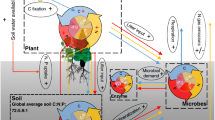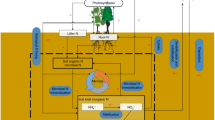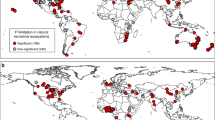Abstract
Soil phosphorus (P) availability is critical to plant productivity in many terrestrial ecosystems. How soil P availability responds to changes in plant diversity remains uncertain, despite the global crisis of rapid biodiversity loss. Our meta-analysis based on 180 studies across various ecosystems (croplands, grasslands, forests and pot experiments) shows that, on average, soil total P, phosphatase activity and available P are 6.8%, 8.5% and 4.6%, respectively, higher in species mixtures than in monocultures. The mixture effect on phosphatase activity becomes more positive with increasing species and functional group richness, with more pronounced increases in the rhizosphere than in the bulk soil. The mixture effects on soil-available P in the bulk soil do not change, but with increasing species or functional group richness these effects in the rhizosphere soil shift from positive to negative. Nonetheless, enhanced soil phosphatase activity stimulated available P in diverse species mixtures, offsetting increased plant uptake effects that decrease soil-available P. Moreover, the enhancement effects of species richness on soil phosphatase activity are positively associated with increased plant productivity. Our findings highlight that preserving plant diversity could increase soil phosphatase activity and P availability, which sustain the current and future productivity of terrestrial ecosystems.
This is a preview of subscription content, access via your institution
Access options
Access Nature and 54 other Nature Portfolio journals
Get Nature+, our best-value online-access subscription
$29.99 / 30 days
cancel any time
Subscribe to this journal
Receive 12 digital issues and online access to articles
$119.00 per year
only $9.92 per issue
Buy this article
- Purchase on Springer Link
- Instant access to full article PDF
Prices may be subject to local taxes which are calculated during checkout





Similar content being viewed by others
Code availability
The code used in this study is available at figshare (https://doi.org/10.6084/m9.figshare.17476622).
References
Vitousek, P. M., Porder, S., Houlton, B. Z. & Chadwick, O. A. Terrestrial phosphorus limitation: mechanisms, implications, and nitrogen–phosphorus interactions. Ecol. Appl. 20, 5–15 (2010).
Hou, E. Q. et al. Global meta-analysis shows pervasive phosphorus limitation of aboveground plant production in natural terrestrial ecosystems. Nat. Commun. 11, 637 (2020).
Cordell, D., Drangert, J.-O. & White, S. The story of phosphorus: global food security and food for thought. Glob. Environ. Change 19, 292–305 (2009).
Newbold, T. et al. Global effects of land use on local terrestrial biodiversity. Nature 520, 45–50 (2015).
Chen, X. L., Chen, H. Y. H., Searle, E. B., Chen, C. & Reich, P. B. Negative to positive shifts in diversity effects on soil nitrogen over time. Nat. Sustain. 4, 225–234 (2021).
Oelmann, Y. et al. Plant diversity effects on aboveground and belowground N pools in temperate grassland ecosystems: development in the first 5 years after establishment. Glob. Biogeochem. Cy. 25, GB2014 (2011).
Fornara, D. A. et al. Plant effects on soil N mineralization are mediated by the composition of multiple soil organic fractions. Ecol. Res. 26, 201–208 (2011).
Wright, A. J., Wardle, D. A., Callaway, R. & Gaxiola, A. The overlooked role of facilitation in biodiversity experiments. Trends Ecol. Evol. 32, 383–390 (2017).
Oelmann, Y. et al. Above- and belowground biodiversity jointly tighten the P cycle in agricultural grasslands. Nat. Commun. 12, 4431 (2021).
Li, L. et al. Diversity enhances agricultural productivity via rhizosphere phosphorus facilitation on phosphorus-deficient soils. Proc. Natl Acad. Sci. USA 104, 11192–11196 (2007).
Li, L., Tilman, D., Lambers, H. & Zhang, F. S. Plant diversity and overyielding: insights from belowground facilitation of intercropping in agriculture. New Phytol. 203, 63–69 (2014).
Hacker, N. et al. Plant diversity shapes microbe–rhizosphere effects on P mobilisation from organic matter in soil. Ecol. Lett. 18, 1356–1365 (2015).
Vance, C. P., Uhde-Stone, C. & Allan, D. L. Phosphorus acquisition and use: critical adaptations by plants for securing a nonrenewable resource. New Phytol. 157, 423–447 (2003).
Chen, J. et al. Long-term nitrogen loading alleviates phosphorus limitation in terrestrial ecosystems. Glob. Change Biol. 26, 5077–5086 (2020).
Hinsinger, P. et al. P for two, sharing a scarce resource: soil phosphorus acquisition in the rhizosphere of intercropped species. Plant Physiol. 156, 1078–1086 (2011).
Liu, X. J. et al. Plant diversity and species turnover co-regulate soil nitrogen and phosphorus availability in Dinghushan forests, southern China. Plant Soil 464, 257–272 (2021).
Hooper, D. U. & Vitousek, P. M. Effects of plant composition and diversity on nutrient cycling. Ecol. Monogr. 68, 121–149 (1998).
Alberti, G. et al. Tree functional diversity influences belowground ecosystem functioning. Appl. Soil Ecol. 120, 160–168 (2017).
Maddhesiya, P. K., Singh, K. & Singh, R. P. Effects of perennial aromatic grass species richness and microbial consortium on soil properties of marginal lands and on biomass production. Land Degrad. Dev. 32, 1008–1021 (2021).
Zhang, C. B. et al. Effects of plant diversity on nutrient retention and enzyme activities in a full-scale constructed wetland. Bioresour. Technol. 101, 1686–1692 (2010).
Štursová, M. & Baldrian, P. Effects of soil properties and management on the activity of soil organic matter transforming enzymes and the quantification of soil-bound and free activity. Plant Soil 338, 99–110 (2011).
Wu, H. et al. Linkage between tree species richness and soil microbial diversity improves phosphorus bioavailability. Funct. Ecol. 33, 1549–1560 (2019).
Steinauer, K. et al. Plant diversity effects on soil microbial functions and enzymes are stronger than warming in a grassland experiment. Ecology 96, 99–112 (2015).
Zhang, D. S. et al. Increased soil phosphorus availability induced by faba bean root exudation stimulates root growth and phosphorus uptake in neighbouring maize. New Phytol. 209, 823–831 (2016).
Berendse, F., van Ruijven, J., Jongejans, E. & Keesstra, S. Loss of plant species diversity reduces soil erosion resistance. Ecosystems 18, 881–888 (2015).
Forrester, D. I. & Bauhus, J. A review of processes behind diversity–productivity relationships in forests. Curr. Rep. 2, 45–61 (2016).
Batterman, S. A. et al. Phosphatase activity and nitrogen fixation reflect species differences, not nutrient trading or nutrient balance, across tropical rainforest trees. Ecol. Lett. 21, 1486–1495 (2018).
Chen, C., Chen, H. Y. H., Chen, X. & Huang, Z. Meta-analysis shows positive effects of plant diversity on microbial biomass and respiration. Nat. Commun. 10, 1332 (2019).
Hisano, M., Chen, H. Y. H., Searle, E. B. & Reich, P. B. Species-rich boreal forests grew more and suffered less mortality than species-poor forests under the environmental change of the past half-century. Ecol. Lett. 22, 999–1008 (2019).
Chen, X. & Chen, H. Y. H. Plant diversity loss reduces soil respiration across terrestrial ecosystems. Glob. Change Biol. 25, 1482–1492 (2019).
Chen, X. & Chen, H. Y. H. Plant mixture balances terrestrial ecosystem C:N:P stoichiometry. Nat. Commun. 12, 4562 (2021).
Reich, P. B. et al. Species and functional group diversity independently influence biomass accumulation and its response to CO2 and N. Proc. Natl Acad. Sci. USA 101, 10101–10106 (2004).
Chen, X. et al. Effects of plant diversity on soil carbon in diverse ecosystems: a global meta-analysis. Biol. Rev. 95, 167–183 (2020).
Zhang, Y., Chen, H. Y. H. & Reich, P. B. Forest productivity increases with evenness, species richness and trait variation: a global meta-analysis. J. Ecol. 100, 742–749 (2012).
Alewell, C. et al. Global phosphorus shortage will be aggravated by soil erosion. Nat. Commun. 11, 4546 (2020).
Mueller, K. E., Tilman, D., Fornara, D. A. & Hobbie, S. E. Root depth distribution and the diversity–productivity relationship in a long-term grassland experiment. Ecology 94, 787–793 (2013).
Tang, X. Y. et al. Intercropping legumes and cereals increases phosphorus use efficiency; a meta-analysis. Plant Soil 460, 89–104 (2021).
Karanika, E. D., Alifragis, D. A., Mamolos, A. P. & Veresoglou, D. S. Differentiation between responses of primary productivity and phosphorus exploitation to species richness. Plant Soil 297, 69–81 (2007).
Bünemann, E. K., Prusisz, B. & Ehlers, K. in Phosphorus in Action: Biological Processes in Soil Phosphorus Cycling (eds Bünemann, E. et al.) 37–57 (Springer, 2011).
Ma, Z. L. & Chen, H. Y. H. Effects of species diversity on fine root productivity in diverse ecosystems: a global meta-analysis. Glob. Ecol. Biogeogr. 25, 1387–1396 (2016).
Mellado-Vazquez, P. G. et al. Plant diversity generates enhanced soil microbial access to recently photosynthesized carbon in the rhizosphere. Soil Biol. Biochem. 94, 122–132 (2016).
Qin, Y. et al. Arbuscular mycorrhizal fungus differentially regulates P mobilizing bacterial community and abundance in rhizosphere and hyphosphere. Appl. Soil Ecol. 170, 104294 (2022).
Rojo, M. J., Carcedo, S. G. & Mateos, M. P. Distribution and characterization of phosphatase and organic phosphorus in soil fractions. Soil Biol. Biochem. 22, 169–174 (1990).
Barrow, N. The effects of pH on phosphate uptake from the soil. Plant Soil 410, 401–410 (2017).
Button, K. S. et al. Power failure: why small sample size undermines the reliability of neuroscience. Nat. Rev. Neurosci. 14, 365–376 (2013).
Yu, R. P., Li, X. X., Xiao, Z. H., Lambers, H. & Li, L. Phosphorus facilitation and covariation of root traits in steppe species. New Phytol. 226, 1285–1298 (2020).
Moher, D., Liberati, A., Tetzlaff, J., Altman, D. G. & PRISMA Group. Preferred reporting items for systematic reviews and meta-analyses: the PRISMA statement. PLoS Medicine 6, e1000097 (2009).
Jenkins, D. G. & Quintana-Ascencio, P. F. A solution to minimum sample size for regressions. PLoS ONE 15, e0229345 (2020)..
Rohatgi, A. WebPlotDigitizer v.4.5 (Automeris, 2021); https://automeris.io/WebPlotDigitizer
Jobbagy, E. G. & Jackson, R. B. The distribution of soil nutrients with depth:global patterns and the imprint of plants. Biogeochemistry 53, 51–77 (2001).
Trabucco, A. & Zomer, R. Global Aridity Index (Global-Aridity) and Global Potential Evapo-Transpiration (Global-PET) Geospatial Database (CGIAR, 2009); http://www.cgiar-csi.org/data/global-aridity-and-pet-database
Bridgham, S. D., Pastor, J., Mcclaugherty, C. A. & Richardson, C. J. Nutrient-use efficiency: a litterfall index, a model, and a test along a nutrient-availability gradient in North Carolina peatlands. Am. Nat. 145, 1–21 (1995).
Hedges, L. V., Gurevitch, J. & Curtis, P. S. The meta-analysis of response ratios in experimental ecology. Ecology 80, 1150–1156 (1999).
Loreau, M. & Hector, A. Partitioning selection and complementarity in biodiversity experiments. Nature 412, 72–76 (2001).
Pittelkow, C. M. et al. Productivity limits and potentials of the principles of conservation agriculture. Nature 517, 365–368 (2015).
Bates, D. et al. lme4: Linear mixed-effects models using Eigen and S4. R package version 1.1-10 https://cran.r-project.org/web/packages/lme4/index.html (2017).
Zuur, A. F., Ieno, E. N. & Elphick, C. S. A protocol for data exploration to avoid common statistical problems. Methods Ecol. Evol. 1, 3–14 (2010).
Johnson, J. B. & Omland, K. S. Model selection in ecology and evolution. Trends Ecol. Evol. 19, 101–108 (2004).
MuMIn: Multi-model inference. R package version 1.42.1 (2018).
Zuur, A. F., Ieno, E. N., Walker, N., Saveliev, A. A. & Smith, G. M. Mixed Effects Models and Extensions in Ecology with R (Springer, 2009).
Koricheva, J., Gurevitch, J. & Mengersen, K. Handbook of Meta-analysis in Ecology and Evolution (Princeton Univ. Press, 2013).
Graham, M. H. Confronting multicollinearity in ecological multiple regression. Ecology 84, 2809–2815 (2003).
Lefcheck, J. S. piecewiseSEM: piecewise structural equation modelling in R for ecology, evolution, and systematics. Methods Ecol. Evol. 7, 573–579 (2016).
Long, J. A. Interactions: comprehensive, user-friendly toolkit for probing interactions. R package version 1.1.5 https://cran.r-project.org/package=interactions (2021).
Adams, D. C., Gurevitch, J. & Rosenberg, M. S. Resampling tests for meta-analysis of ecological data. Ecology 78, 1277–1283 (1997).
R Core Team. R: A Language and Environment for Statistical Computing (R Foundation for Statistical Computing, 2021).
Acknowledgements
We thank the Discovery Grants program (grant no. RGPIN-2018-05700 to S.C.) of the Natural Sciences and Engineering Research Council of Canada (NSERC) for supporting this research. X.C. wishes to thank NSERC and the Government of Canada for a Banting Postdoctoral Fellowship. H.Y.H.C. was also supported by NSERC grants (nos. RGPIN-2019-5109 and STPGP506284).
Author information
Authors and Affiliations
Contributions
X.C., H.Y.H.C. and S.C. designed the study. X.C. collected data. X.C. performed the meta-analysis and wrote the first draft of the manuscript and all authors wrote interactively through multiple rounds of revisions.
Corresponding author
Ethics declarations
Competing interests
The authors declare no competing interests.
Peer review
Peer review information
Nature Ecology & Evolution thanks Chunjie Li and the other, anonymous, reviewer(s) for their contribution to the peer review of this work. Peer reviewer reports are available.
Additional information
Publisher’s note Springer Nature remains neutral with regard to jurisdictional claims in published maps and institutional affiliations.
Extended data
Extended Data Fig. 1
Geographical distribution of experiments testing plant mixture effects on soil total P, phosphatase activity and available P collected for this meta-analysis.
Supplementary information
Rights and permissions
About this article
Cite this article
Chen, X., Chen, H.Y.H. & Chang, S.X. Meta-analysis shows that plant mixtures increase soil phosphorus availability and plant productivity in diverse ecosystems. Nat Ecol Evol 6, 1112–1121 (2022). https://doi.org/10.1038/s41559-022-01794-z
Received:
Accepted:
Published:
Issue Date:
DOI: https://doi.org/10.1038/s41559-022-01794-z
This article is cited by
-
Biochar affects compressive strength of Portland cement composites: a meta-analysis
Biochar (2024)
-
Phosphorus limitation of Pinus massoniana reforestation increases with stand development: evidence from plant, leaf litter, and soil
Plant and Soil (2024)
-
Plant diversity and nitrogen addition affect the architecture of plant–soil–microbe stoichiometric networks
Plant and Soil (2023)
-
Enhanced phosphorus-fertilizer-use efficiency and sustainable phosphorus management with intercropping
Agronomy for Sustainable Development (2023)
-
Litter decomposition in the mixed Chromolaena odorata (Asteraceae, herbaceous)-Cajanus cajan (Fabaceae, ligneous) fallow: synergistic or antagonistic mixing effect?
Agroforestry Systems (2023)



